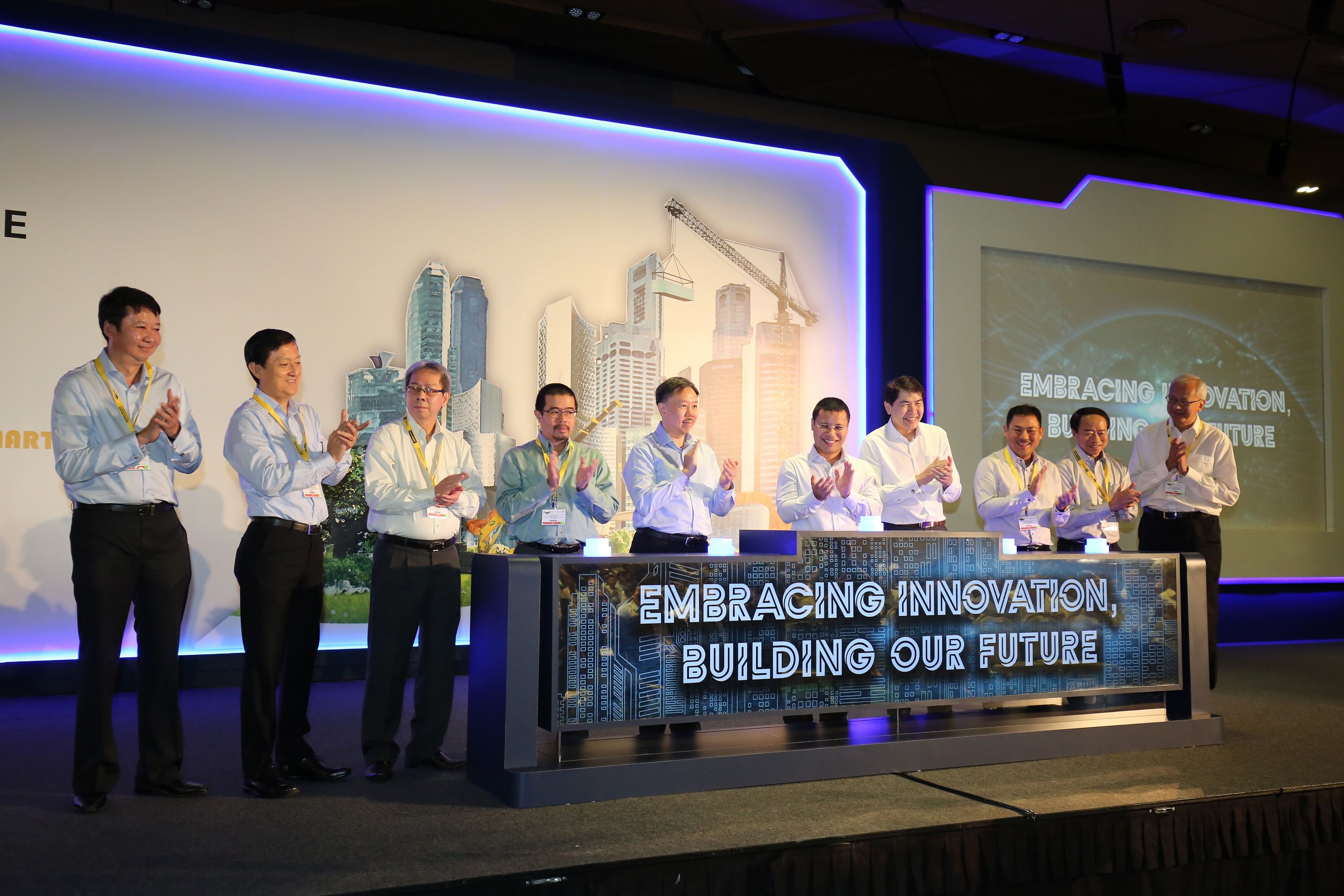SINGAPORE - Instead of sweat, mud and grime, Singaporeans joining the building and construction industry in the near future can expect a career of digital design and cutting-edge technologies which prioritise productivity and innovation over manual work.
The Building and Construction Authority (BCA) targets to have 80,000 personnel trained in such technologies to enter the industry by 2025. There are currently 32,600 trained in these areas.
The move is part of the newly launched Construction Industry Transformation Map (ITM), which is designed to pave the way for the creation of more attractive and highly skilled construction jobs in a sector that has seen dwindling interest from young Singaporeans, and low productivity resulting in a high reliance on low-skilled foreign workers.
Second Minister for National Development Desmond Lee introduced the road map at the opening ceremony of the Singapore Construction Productivity Week at the Singapore Expo Convention and Exhibition Centre on Tuesday (Oct 24).
Mr Lee, who is also the Minister for Social and Family Development and has been playing an active role in the ITM's development, said: "Essentially, we are speaking about transformation of the whole construction sector - the entire process and value chain, from end to end. This is not just a slogan, what we want to do is set the conditions for the entire industry to upgrade, to upskill, and to offer cutting-edge products and services to Singapore, and to the region, and to the world. This is particularly salient given the difficult market conditions that many of us face today, which make it imperative for us to start now."
The plan has been around a decade in the making, ever since BCA started to explore the feasibility of using new construction paradigms, such as Design for Manufacturing and Assembly (DfMA), to boost productivity rates and change the industry into one that resembles a highly productive manufacturing line in a factory.
This is achieved through technology like prefabricated prefinished volumetric construction (PPVC), where large building modules manufactured in offsite factories are assembled in a Lego-like manner at construction sites.
Built this way, construction sites can see up to 40 per cent of manpower savings since most of the work has been done already. This means faster completion times, fewer work incidents and a cleaner site.
By 2020, BCA targets 40 per cent of all projects to adopt DfMA. Currently, only 10 per cent of projects have used or are using the method.

-
Key changes to the construction industry
-
Details of the construction industry transformation map were revealed on Tuesday (Oct24). Here are some key points:
1. Build a higher-skilled workforce focused on digital technologies
The plan is to attract more IT-savvy Singaporeans into the sector, with jobs that involve higher skills, more competitive salaries and a better working environment. A task force, comprising BCA, institutes of higher learning and industry associations, will provide more structured internships and creating a comprehensive training pathway for people to pick up new building technologies.
2. Increase the use of more productive construction methods
- Design for Manufacturing and Assembly (DfMA), a highly productive method of construction which moves traditional onsite work into offsite factory environments, should see 40 per cent adoption in all projects by 2020. The Government will also continue to roll out private land sales that specify the use of DfMA. There will also be up to 10 local prefabrication hubs by 2020.
- The digitisation of the construction processes through IDD, which allows various stakeholders to collaborate from an early stage, has been mandated for certain key projects. BCA will develop standards to ensure interoperability of IDD systems, such as Building Information Modelling, and will pilot programmes that allow smaller firms unable to develop in-house software to test shared platforms.
3. Build progressive and collaborative firms
The Government will review public procurement practices to place higher weighting on non-price components, such as productivity and quality scores. A working committee will be set up to look at collaborative contracting models to facilitate greater cooperation among firms.
The ITM also charts the adoption of other high-tech methods in the construction pipeline, including green building technologies, and a move to integrate designers, builders, sub-contractors and facility managers in the building's life cycle through an approach known as Integrated Digital Delivery (IDD).
IDD can help stakeholders achieve savings by looking at the life cycle of a building at the design stage, said Mr Lee. Operations and maintenance of a building throughout its life cycle can cost up to four to five times more than actual construction, so with IDD, potential life cycle savings will be considerable.
Said BCA chief executive officer Hugh Lim: "What we don't want is for contractors to import more and more foreign workers to complete the job. We want to try to maintain the number of foreign workers at the current level, yet be able to cope with an increase in output as more big projects start kicking in."
As of June, there are 296,700 foreign workers holding construction work permits.
To meet this demand, "a more technologically advanced workforce is needed", said Mr Lim.
Out of the 80,000 personnel in the industry, 35,000 will be trained in DfMA, 20,000 in Integrated Digital Delivery and 25,000 in green building technologies.
A built environment SkillsFuture tripartite task force, involving BCA, institutes of higher learning and industry associations, will look into developing a comprehensive training pathway for new entrants and upgrading working adults.
Said Mr Lee: "What we are doing is ambitious, but this is necessary ambition. We all want the same thing - a vibrant and successful built environment sector. We want strong and profitable firms that thrive locally and overseas, we want good jobs for Singaporeans, we want cutting-edge capabilities anchored in Singapore. This will be no small feat and the journey will be tough, but we can do it together."


